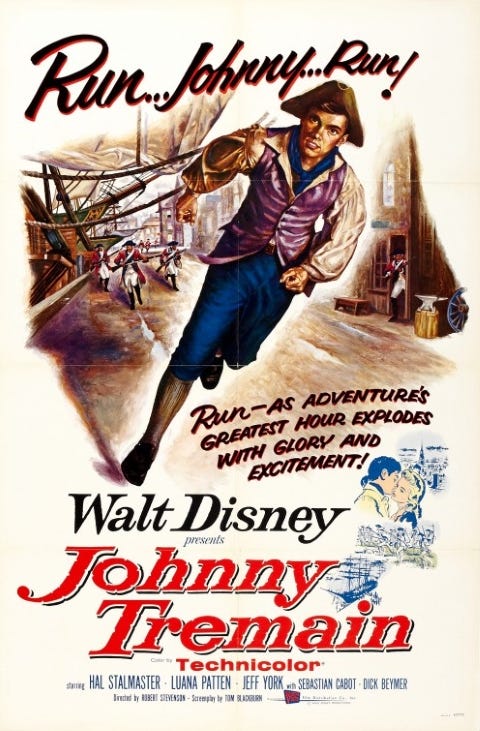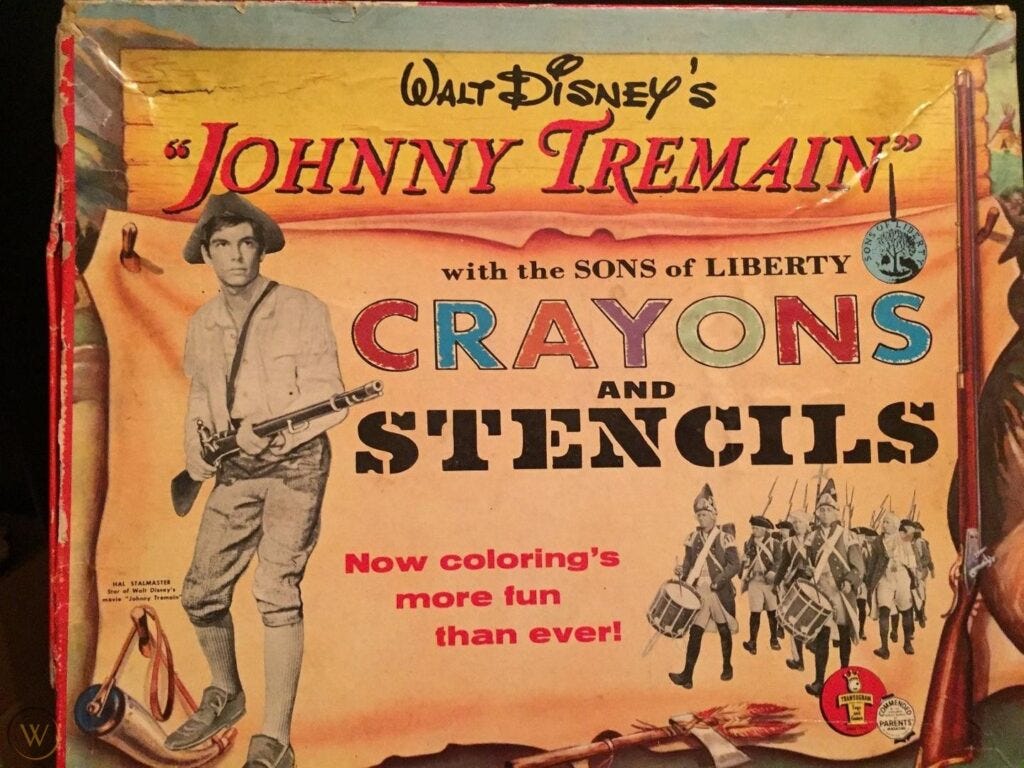Disney Plus-Or-Minus: Johnny Tremain
Branching into television production worked out extremely well for Walt Disney. In an era when TV was still broadcast in black-and-white, Walt was forward-thinking enough to insist on filming in color. This enabled him to repackage the enormously popular Davy Crockett serials and release them theatrically. Those two features proved that the quality of Walt’s TV productions could hold their own on the big screen.
Johnny Tremain was intended to premiere on the Disneyland TV series, just like Davy Crockett. Walt would continue to make historical adventures a key element of the show for years with serials like The Saga Of Andy Burnett and The Nine Lives Of Elfego Baca. But after screening Johnny Tremain, Walt decided it was good enough to skip television and premiere theatrically instead.
If he was going for longevity, Walt couldn’t have picked better source material. Esther Forbes’ Newbery Medal-winning novel was published in 1943. It’s been a fixture of middle school curriculums ever since. The book has never gone out of print and in 2000, Publishers Weekly placed it at #16 on their list of all-time best-selling children’s books. If you’ve somehow managed to go your entire life without being exposed to Johnny Tremain, you must have gone to a school that didn’t have books.
Tom Blackburn, Disney’s go-to writer for historical adventure projects, adapted the book. He and composer George Bruns also tried to recapture their “Ballad of Davy Crockett” magic with a couple of original songs, although “The Liberty Tree” didn’t exactly rocket to the top of the charts. Blackburn’s script betrays the movie’s TV origins, splitting the story into two distinct episodes.
In the first, we meet our young hero. Johnny Tremain (Hal Stalmaster) is an apprentice silversmith in Boston working under Ephraim Lapham (Will Wright). Wealthy merchant Jonathan Lyte (Sebastian Cabot) wants to commission a replacement piece but Lapham refuses, concerned that his skills are no longer up to the task. Johnny insists that he’s up to the challenge and accepts the work under a tight deadline.
While working on the piece, Johnny reveals a secret to Lapham’s daughter, Priscilla (played by former Disney child star Luana Patten, considerably grown up from her appearances in Song Of The South and So Dear To My Heart): Johnny is in fact related to Lyte. Before she died, his mother gave him her christening cup engraved with the Lyte family crest. But Johnny wants to make his own way in the world and has decided not to confront Lyte with his story unless he absolutely must.
For advice on Lyte’s commission, Johnny goes to visit Boston’s other prominent silversmith, Paul Revere (Walter Sande). Revere, of course, is a member of the Sons of Liberty, the revolutionary organization formed by Samuel Adams (Rusty Lane). Printer’s apprentice Rab Silsbee (future West Side Story and Twin Peaks star Richard Beymer) encourages Johnny to get involved but Johnny prefers to stay out of it.
Taking Revere’s advice, Johnny breaks the Sabbath to finish Lyte’s commission. But an accident badly burns his hand, rendering it useless. The Laphams are forced to let him go. Unable to find work anywhere else, Johnny appeals to Lyte, showing him the cup his mother left him. Rather than taking him in, Lyte accuses Johnny of burglary and has him arrested. Josiah Quincy (Whit Bissell) defends Johnny in court, calling Priscilla as a witness and clearing his name. Grateful for all their help, Johnny takes a job delivering newspapers and acting as a messenger for the Sons of Liberty.
From this point on, Johnny has a front-row seat for all the key events of the American Revolution. He and Rab take part in the Boston Tea Party. He’s there for Paul Revere’s famous Midnight Ride to Lexington. He’s on the front lines of the Battles of Lexington and Concord. If he’d been carrying a gun, he probably would have been responsible for the shot heard round the world.
There’s nothing about Johnny Tremain that I would describe as actively bad. It’s a well-made film with high production values and a capable cast. But it is an extremely old-fashioned movie, a little bit stiff and stagy. At times, it feels more like a professionally made Independence Day pageant than a film, especially when the entire cast marches through the streets of Boston singing “The Liberty Tree”. Hamilton, this isn’t.
The biggest problem is that Forbes’ novel has had every last trace of grit and toughness scrubbed out of it by the Disney Sterilization Crew. The book treats the Battles of Lexington and Concord with some degree of realism. Rab is wounded and dies painfully (spoiler alert for a novel you really should have read by now, I guess). The movie treats it like an exciting romp through the woods with high spirits and laughter all around. I don’t expect Johnny Tremain to turn into Saving Private Ryan but any anti-war message from Forbes’ book has been completely jettisoned.
Much of the pleasure of Johnny Tremain comes from watching the cavalcade of character actors as real-life historical figures. Walter Sande is a particular treat as Paul Revere, giving the silversmith a down-to-earth decency that goes beyond the usual thumbnail sketch of kids’ Intro to American History books. Sebastian Cabot is smugness personified as Lyte. And Jeff York (Mike Fink, King of the River!) is virtually unrecognizable as James Otis, a founding member of the Sons of Liberty whose behavior has become increasingly erratic after a head injury.
Considering the presence of Luana Patten, you might expect Walt to cast her former co-star Bobby Driscoll as Johnny. But Driscoll had already been arrested once for marijuana possession by this point, so Walt cast newcomer Hal Stalmaster in the lead role. He isn’t a natural actor but he certainly sells Johnny’s earnestness.
If you’ve paid attention to the credits of virtually any movie or TV show from the second half of the 20th century, you’ve seen the name of Hal’s older brother, the legendary casting director Lynn Stalmaster. Lynn was already in casting when Hal got the part in Johnny Tremain and was evidently surprised to find out that his younger brother had any interest in acting. As it turned out, Lynn was right. Hal’s interests did end up lying elsewhere. Walt cast him in another Revolutionary War TV serial, The Swamp Fox starring Leslie Nielsen. But apart from a few small TV roles, Hal retired from acting entirely before the end of the 1960s. He ended up following in his brother’s footsteps, working in Disney’s casting department for a time before becoming a talent agent.
But Johnny Tremain’s most significant addition to the Disney roster was director Robert Stevenson. Stevenson was a British director who emigrated to the US in the early 1940s. He was under contract to David O. Selznick, for whom he made the 1943 version of Jane Eyre starring Orson Welles, and made a few films at RKO before moving into television. He was a prolific TV director, helming multiple episodes of shows like Alfred Hitchcock Presents and Gunsmoke.
When Walt hired Stevenson to direct Johnny Tremain, it was just another TV gig. It became a life-changing experience. Over the course of the next twenty-plus years, Stevenson would direct another 18 features for the studio, nabbing an Oscar nomination for his work on Mary Poppins. In 1977, Variety named him the most commercially successful director of all time with 16 films on their list of all-time highest-grossing films. Needless to say, we’ll be seeing a lot more Robert Stevenson movies in this column.
It’s hard to say whether or not Walt’s theatrical gamble paid off for Johnny Tremain. Box office numbers weren’t widely reported back in 1957. But Walt certainly acted like he expected another Davy Crockett-size hit. He flooded stores with Johnny Tremain toys, comics, and other tchotchkes. There were even official Johnny Tremain tri-cornered hats to try and convince kids that coonskin caps were so 1955.
The movie also inspired Walt to propose a new addition to Disneyland called Liberty Street recreating Revolutionary-era Boston. Liberty Street eventually morphed into Liberty Square in Walt Disney World’s Magic Kingdom. The Johnny Tremain connections might not be quite as overt as Walt had once planned but the Liberty Tree, an enormous 100-year-old southern live oak, still dominates the area.
Johnny Tremain also stayed alive through screenings on TV and schools. That original TV format lent itself to editing, so in addition to returning to its original berth on Disneyland, Disney edited it down further to focus on sequences like Paul Revere’s ride. For years, even if you hadn’t seen Johnny Tremain in its entirety, you’d probably seen some of it on a day when your history teacher needed a break.
Today, Johnny Tremain isn’t impossible to find but Disney certainly isn’t treating it like one of their crown jewels. They haven’t released it on Blu-ray or made it available on Disney+ but you can rent or buy an HD version digitally on Vudu or iTunes. It isn’t a terrible movie but I think it’s destined to remain stuck in the past. Nostalgia buffs may enjoy revisiting it. But if you’re new to the world of Johnny Tremain, I don’t think you’ll be inspired to buy your own tri-cornered hat.
VERDICT: Disney Neutral







